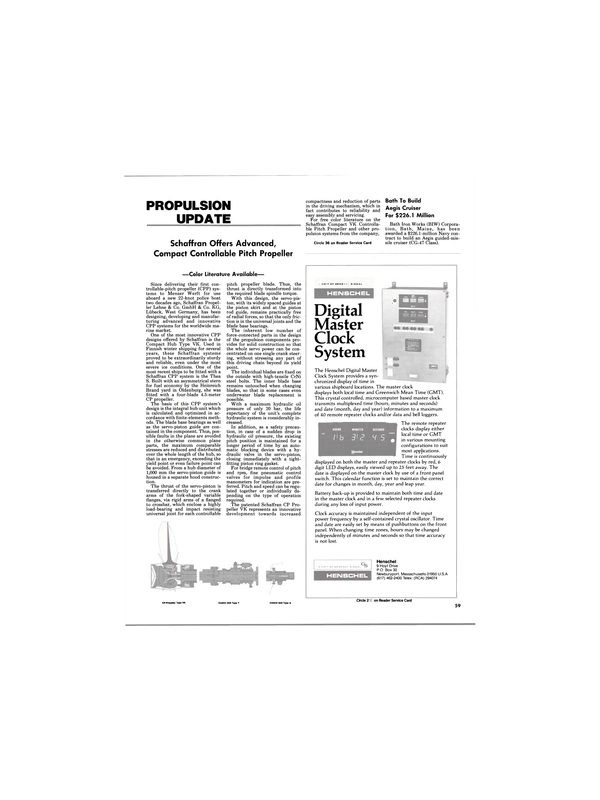
Schaffran Offers Advanced, Compact Controllable Pitch Propeller
—Color Literature Available— Since delivering their first controllable- pitch propeller (CPP) systems to Menzer Werft for use aboard a new 22-knot police boat two decades ago, Schaffran Propeller Lehne & Co. GmbH & Co. KG, Liibeck, West Germany, has been designing, developing and manufacturing advanced and innovative CPP systems for the worldwide marine market.
One of the most innovative CPP designs offered by Schaffran is the Compact Hub Type VK. Used in Finnish winter shipping for several years, these Schaffran systems proved to be extraordinarily sturdy and reliable, even under the most severe ice conditions. One of the most recent ships to be fitted with a Schaffran CPP system is the Thea S. Built with an asymmetrical stern for fuel economy by the Heinreich Brand yard in Oldenburg, she was fitted with a four-blade 4.5-meter CP propeller.
The basis of this CPP system's design is the integral hub unit which is calculated and optimized in accordance with finite-elements methods.
The blade base bearings as well as the servo-piston guide are contained in the component. Thus, possible faults in the plane are avoided in the otherwise common plane parts, the maximum comparable stresses are reduced and distributed over the whole length of the hub, so that in an emergency, exceeding the yield point or even failure point can be avoided. From a hub diameter of 1,000 mm the servo-piston guide is housed in a separate hood construction.
The thrust of the servo-piston is transferred directly to the crank arms of the fork-shaped variable flanges, via rigid arms of a flanged to crossbar, which enclose a highly load-bearing and impact resisting universal joint for each controllable pitch propeller blade. Thus, the thrust is directly transformed into the required blade spindle torque.
With this design, the servo-piston, with its widely spaced guides at the piston skirt and at the piston rod guide, remains practically free of radial forces, so that the only friction is in the universal joints and the blade base bearings.
The inherent low number of force-connected parts in the design of the propulsion components provides for solid construction so that the whole servo power can be concentrated on one single crank steering, without stressing any part of this driving chain beyond its yield point.
The individual blades are fixed on the outside with high-tensile CrNi steel bolts. The inner blade base remains untouched when changing blades, so that in some cases even underwater blade replacement is possible.
With a maximum hydraulic oil pressure of only 20 bar, the life expectancy of the unit's complete hydraulic system is considerably increased.
In addition, as a safety precaution, in case of a sudden drop in hydraulic oil pressure, the existing pitch position is maintained for a longer period of time by an automatic blocking device with a hydraulic valve in the servo-piston, closing immediately with a tightfitting piston ring gasket.
For bridge remote control of pitch and rpm, fine pneumatic control valves for impulse and profile manometers for indication are preferred.
Pitch and speed can be regulated together or individually depending on the type of operation required.
The patented Schaffran CP Propeller VK represents an innovative development towards increased compactness and reduction of parts in the driving mechanism, which in fact contributes to reliability and easy assembly and servicing.
For free color literature on the Schaffran Compact VK Controllable Pitch Propeller and other propulsion systems from the company, Circle 36 on Reader Service Card
Read Schaffran Offers Advanced, Compact Controllable Pitch Propeller in Pdf, Flash or Html5 edition of April 1988 Maritime Reporter
Other stories from April 1988 issue
Content
- MHI Delivers Newest Tanker For Chevron Fleet page: 5
- New Nirex Freshwater Distiller And Ice Machine From Alfa-Laval page: 6
- Repower With Cummins NTA-855-Ms Gives Pushboat A New Life page: 7
- System Expansion For WLO Radio page: 7
- Penn Ship Names Veteran Shipbuilder Grandin Vought Operations Vice President page: 7
- Krupp Atlas Elektronik Navaids page: 8
- A.S.N.E. DAY '88 A CENTENNIAL CELEBRATION page: 10
- Aeroquip Offers Free Hose Line Training Bulletin page: 19
- Woodward Governor Forms International Operations Division page: 20
- Moss Point Marine Delivers First Of Two Navy Landing Craft page: 21
- Six-Patrol-Boat 'Package' Completed By Halter Marine For Ecuadoran Navy page: 22
- Two New Low-Cost Products From Furuno: Temperature Sensor, And Net Sounder page: 22
- OTC-'88 20th ANNIVERSARY SPECIAL PREVIEW page: 24
- Astilleros Espanoles Yards Report Full Orderbooks Well Into 1989 page: 50
- New 52-Page Catalog On Lighting Offered By Aqua Signal page: 51
- Radio Holland USA Opens New Service Centers page: 51
- Halter Converts Supply Boat To Crabber/Processor In 90 Days page: 52
- POSITION/LIMIT SENSING SOLUTIONS IN HARSH ENVIRONMENTS page: 54
- Ingalls Shipbuilding Awarded $769-Million Navy Contract To Build Four Aegis Cruisers page: 56
- Riedel International Announces Key Promotions page: 56
- Halter Marine Converts Crewboat For Fisheries Patrol Service page: 57
- Skipperliner Shipyards Delivers Cummins-Powered Passenger Vessel page: 58
- Schaffran Offers Advanced, Compact Controllable Pitch Propeller page: 59
- Port of Genoa Attracts New Container Business Under Innovative Leadership page: 60
- Perkins Marketing Light Marine Engines As Power Prestige Line page: 61
- Literature Offered On Marine Cross Reference Data Base Compact Disc page: 61
- Datamarine's ^Chartlink' Adds New Dimension To Loran/Satnav Navigation page: 62
- Caterpillar Announces 1.1 -Liter Family Of Marine Diesel Engines page: 62
- Robertson-Shipmate's Multi-Station Commercial VHF Radiotelephone Now Approved For Use In U.S. page: 64
- Reiss Purchases Rexnord Defense Systems —Renamed TANO Corp. page: 65
- Free Literature Offered On Full Line Of Steering Gears From Tenf jord page: 65
- Academy Chief Elected To ASNE page: 66
- Deutz MWM Diesel Engine Series Offer Distinct Advantages For Passenger Boat Propulsion page: 66
- Seaward International Supplies Large Fleet Mooring Buoys To Navy For Use In Pacific Islands page: 69
- SASMEX '88 To Be Held April 26-28 In London page: 70
- Hyundai Heavy Industries To Build Ethylene Carriers page: 72
- MAN B&W's New 2 8 / 3 2 A Diesel: Improved Fuel Economy With Same Reliability page: 73
- Fluid Energy Launches 64-Foot Passenger Submarine page: 78


